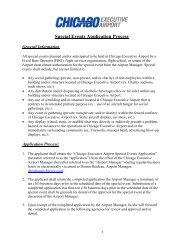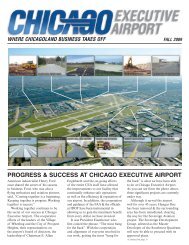Here - Chicago Executive Airport
Here - Chicago Executive Airport
Here - Chicago Executive Airport
You also want an ePaper? Increase the reach of your titles
YUMPU automatically turns print PDFs into web optimized ePapers that Google loves.
<strong>Chicago</strong> <strong>Executive</strong> <strong>Airport</strong> Economic Impact Study–2007 Page 5-1<br />
Chapter 5 - Business User Impacts and Other Benefits<br />
As regional business markets become more national and even global in scale, airports are<br />
increasingly seen as prerequisites for local economic development. However, insufficient<br />
transportation systems can seriously impede actual economic development. As time constraints<br />
and dependability become increasingly important, the role of air transport for both goods and<br />
personnel continues to increase. Further, the commercial air transportation system struggles to<br />
accommodate demand as airline load factors continue to reach new highs. 9 Given this<br />
paradigm, corporations increasingly use the more direct, dependable and controllable flight<br />
options that general aviation transport provides in moving key personnel and essential freight.<br />
This is especially evident in the <strong>Chicago</strong> area where O’Hare International <strong>Airport</strong>, one of the<br />
busiest in the world, is continually plagued by flight delays and/or cancellations due to<br />
congestion and severe weather. While the preceding economic impact analysis evaluated the<br />
jobs, income and output associated with the businesses that provide air transport, it did not<br />
address the value of air transport to the businesses that depend on <strong>Chicago</strong> <strong>Executive</strong> <strong>Airport</strong>.<br />
This user impact is vital to the <strong>Chicago</strong> area economy. However, no definitive manner exists to<br />
measure the value of the airport to the major business users.<br />
Nonetheless, the value is real and is addressed below. This section begins with an overview of<br />
the National Business Aviation Association (NBAA) and General Aviation Manufactures<br />
Association (GAMA) perspective, followed by a summary of typical business user surveys. A<br />
quantitative perspective is then provided through an estimate of employment levels at the<br />
businesses who have corporate aircraft based at <strong>Chicago</strong> <strong>Executive</strong>. The chapter concludes<br />
with qualitative description of the qualitative benefits of how the <strong>Airport</strong>’s activities affect the<br />
community’s quality of life.<br />
5.1 Aviation-Dependent Industries<br />
Many of the nation's leading employers that use general aviation as a business tool are<br />
members of the NBAA. The NBAA’s Business Aviation Fact Book 2004 indicates that<br />
approximately 75% of all businesses included in the Fortune 500 operate general aviation<br />
aircraft. Moreover, 92 of the Fortune 100 companies operate general aviation aircraft. A<br />
detailed analysis conducted for NBAA in 2004 also indicated that among the Fortune 500 there<br />
were more than twice as many companies operating general aviation aircraft as non-operators.<br />
Business use of general aviation aircraft at <strong>Chicago</strong> <strong>Executive</strong> <strong>Airport</strong> ranges from small singleengine<br />
aircraft rental to multiple aircraft corporate fleets supported by dedicated flight crews and<br />
9 The ATA Factbook – 2007 reports seat load factors (occupied percent of commercial aircraft seats) of<br />
77.6% in 2005 and 79.2% in 2006. While these factors fluctuate monthly, the general annual trend<br />
continues to rise.<br />
Wilbur Smith Associates November 2007




